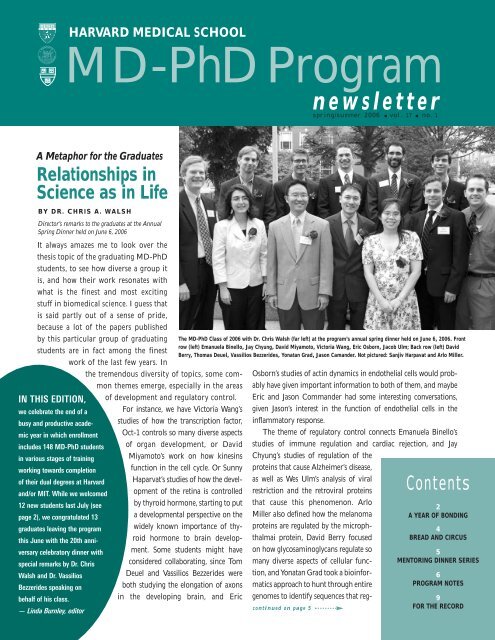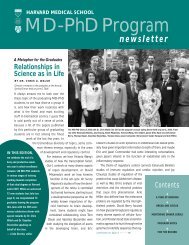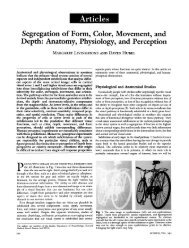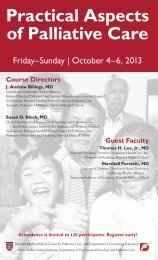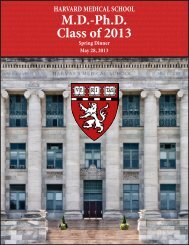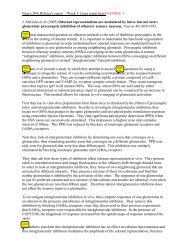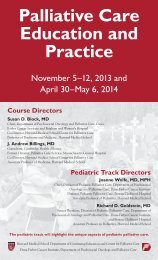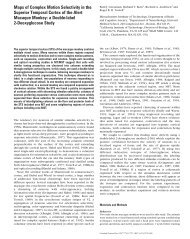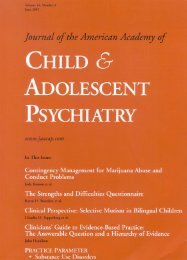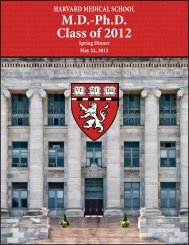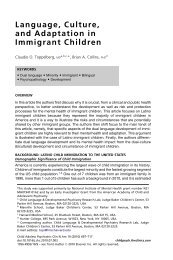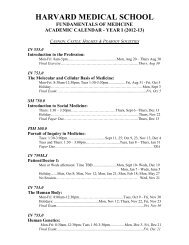MD-PhDProgram - Harvard Medical School - Harvard University
MD-PhDProgram - Harvard Medical School - Harvard University
MD-PhDProgram - Harvard Medical School - Harvard University
Create successful ePaper yourself
Turn your PDF publications into a flip-book with our unique Google optimized e-Paper software.
HARVARD MEDICAL SCHOOL<br />
<strong>MD</strong>-<strong>PhDProgram</strong><br />
newsletter<br />
spring/summer 2006 ■ vol. 17 ■ no. 1<br />
A Metaphor for the Graduates<br />
Relationships in<br />
Science as in Life<br />
BY DR. CHRIS A. WALSH<br />
Director’s remarks to the graduates at the Annual<br />
Spring Dinner held on June 6, 2006<br />
It always amazes me to look over the<br />
thesis topic of the graduating <strong>MD</strong>-PhD<br />
students, to see how diverse a group it<br />
is, and how their work resonates with<br />
what is the finest and most exciting<br />
stuff in biomedical science. I guess that<br />
is said partly out of a sense of pride,<br />
because a lot of the papers published<br />
by this particular group of graduating<br />
students are in fact among the finest<br />
work of the last few years. In<br />
the tremendous diversity of topics, some common<br />
themes emerge, especially in the areas<br />
IN THIS EDITION, of development and regulatory control.<br />
we celebrate the end of a For instance, we have Victoria Wang’s<br />
busy and productive acade- studies of how the transcription factor,<br />
mic year in which enrollment Oct-1 controls so many diverse aspects<br />
includes 148 <strong>MD</strong>-PhD students of organ development, or David<br />
in various stages of training Miyamoto’s work on how kinesins<br />
working towards completion function in the cell cycle. Or Sunny<br />
of their dual degrees at <strong>Harvard</strong> Haparvat’s studies of how the devel-<br />
and/or MIT. While we welcomed opment of the retina is controlled<br />
12 new students last July (see by thyroid hormone, starting to put<br />
page 2), we congratulated 13 a developmental perspective on the<br />
graduates leaving the program widely known importance of thy-<br />
this June with the 20th anniroid hormone to brain developversary<br />
celebratory dinner with ment. Some students might have<br />
special remarks by Dr. Chris considered collaborating, since Tom<br />
Walsh and Dr. Vassilios<br />
Deuel and Vassilios Bezzerides were<br />
Bezzerides speaking on<br />
both studying the elongation of axons<br />
behalf of his class.<br />
— Linda Burnley, editor<br />
in the developing brain, and Eric<br />
The <strong>MD</strong>-PhD Class of 2006 with Dr. Chris Walsh (far left) at the program’s annual spring dinner held on June 6, 2006. Front<br />
row (left) Emanuela Binello, Jay Chyung, David Miyamoto, Victoria Wang, Eric Osborn, Jacob Ulm; Back row (left) David<br />
Berry, Thomas Deuel, Vassilios Bezzerides, Yonatan Grad, Jason Camander. Not pictured: Sanjiv Harpavat and Arlo Miller.<br />
Osborn’s studies of actin dynamics in endothelial cells would probably<br />
have given important information to both of them, and maybe<br />
Eric and Jason Commander had some interesting conversations,<br />
given Jason’s interest in the function of endothelial cells in the<br />
inflammatory response.<br />
The theme of regulatory control connects Emanuela Binello’s<br />
studies of immune regulation and cardiac rejection, and Jay<br />
Chyung’s studies of regulation of the<br />
proteins that cause Alzheimer’s disease,<br />
as well as Wes Ulm’s analysis of viral<br />
restriction and the retroviral proteins Contents<br />
that cause this phenomenon. Arlo<br />
2<br />
Miller also defined how the melanoma<br />
A YEAR OF BONDING<br />
proteins are regulated by the microph-<br />
4<br />
thalmai protein, David Berry focused<br />
BREAD AND CIRCUS<br />
on how glycosaminoglycans regulate so<br />
5<br />
many diverse aspects of cellular func- MENTORING DINNER SERIES<br />
tion, and Yonatan Grad took a bioinfor-<br />
6<br />
matics approach to hunt through entire<br />
PROGRAM NOTES<br />
genomes to identify sequences that reg-<br />
9<br />
FOR THE RECORD<br />
continued on page 5
IN THEIR OWN WORDS<br />
A Year of Bonding<br />
First-Year <strong>MD</strong>-PhDs Now<br />
Ready for Next Step<br />
Aseemingly disparate group of aspiring scientists and clinicians,<br />
this year’s <strong>MD</strong>-PhD class brings with it a variety of<br />
interests, both academic and extracurricular. From the<br />
moment our summer course began, there was excitement all<br />
around. We quickly came together through Sunday night Vanderbilt<br />
Hall potlucks, daytrips around Boston, and late night treks for ice<br />
cream. In the coming years, we expect this bond to grow stronger<br />
and to be a source of support within our group. Despite our varied<br />
obsession with the Red Sox or Yankees, 9 pm bedtimes versus midnight<br />
Minipreps, and love for warm weather compared to the frigid<br />
chills of Boston, our group shares a strong common interest in the<br />
pursuit of free food and, of course, a little bit of research if time permits.<br />
Below are short descriptions of each of the members of the firstyear<br />
class. These blurbs highlight the diverse backgrounds of the<br />
group, and the tremendous contribution that such diversity is sure<br />
to make in our future development as physician-scientists.<br />
Katrina Abuabara, a native of Northern California, stayed true to<br />
her roots and graduated from Stanford <strong>University</strong> in 2001 with a BA<br />
in human biology and a MA in sociology. She then migrated south<br />
to Mexico City, where she worked on reproductive health epidemiology<br />
in Latin America. She has since focused on disease modeling<br />
and decision analysis at UCSF and the <strong>Harvard</strong> <strong>School</strong> of Public<br />
Health, and is currently interested in infectious disease and international<br />
health policy. Even after two years in Boston, she still isn’t convinced<br />
that winter is a time to be indoors, and you may just find her<br />
bundled in down, biking along the Charles or jogging in Brookline.<br />
<strong>MD</strong>-PhD<br />
PROGRAM<br />
newsletter<br />
Editor<br />
Linda Burnley<br />
Assistant Editor<br />
Janelle McCluskey<br />
Designer<br />
Kathleen Sayre<br />
PHOTO CREDITS: LINDA BURNLEY,<br />
MOSHE JAKUBOWSKI, LIZA GREEN<br />
This newsletter is published twice a year<br />
since it was first published in 1990.<br />
©COPYRIGHT 2006<br />
BY THE PRESIDENT AND FELLOWS OF<br />
HARVARD COLLEGE<br />
www.hms.harvard.edu/md_phd<br />
2 HARVARD <strong>MD</strong>-PHD PROGRAM newsletter<br />
Joseph Franses was born in<br />
West Lafayette, Indiana, and<br />
attended Purdue <strong>University</strong>,<br />
where he earned bachelors<br />
degrees in chemistry and chemical<br />
engineering in 2005. After<br />
college, he married his high<br />
school and college sweetheart,<br />
Nicole Waples, before coming to<br />
HMS. In his spare time he enjoys<br />
playing on the dominant HST<br />
intramural basketball team,<br />
reading, trying to not forget how<br />
to play the piano, and finding<br />
more things that need to be fixed<br />
in his new condo. Joseph’s past<br />
research interests included interfacial<br />
chemistry and engineering,<br />
organometallic chemistry,<br />
and biochemical engineering;<br />
his current research interests<br />
Erin Loeliger and Marie Hollenhorst at the first Joslin/<strong>MD</strong>-PhD Program poster<br />
symposium in August 2005.<br />
include cardiovascular drug delivery, biomaterials, and vascular<br />
biology. He hopes to, in chronological order: own a dog, have some<br />
kids, and become a cardiologist and researcher. Joseph is very honored<br />
to be part of such a fantastic group of colleagues.<br />
Vijay Ganesh was born and raised in upstate New York. As he headed<br />
to <strong>Harvard</strong> to pursue a degree in biology, his prescient mother<br />
told him that his good fortunes would follow him to Boston.<br />
Unfortunately, this has come to mean that in the six years since he<br />
left his hometown, the N.Y. Yankees and N.Y. Giants have failed to<br />
win a single championship, while the historically inept Red Sox and<br />
Patriots have experienced unprecedented luck. Perhaps as a testament<br />
to his emotional fortitude, Vijay decided to remain in Boston<br />
for his <strong>MD</strong>-PhD. He is excited to continue his research training in<br />
neuroscience. Though he knows that a career as a physician-scientist<br />
is difficult to craft, what he has witnessed in Boston and abroad<br />
tells him that anything is possible. This delusion keeps him motivated,<br />
and his first-rate classmates in HST keep him happy—both<br />
in class, and on the tennis, basketball, and squash courts.<br />
Marie Hollenhorst is from Saratoga, California. She attended<br />
Stanford <strong>University</strong>, where she studied biology and did research on<br />
the molecular mechanism of T cell anergy. After graduating, she<br />
made the strange choice to trade Palo Alto’s palm-tree-lined streets<br />
for the gray skies of Boston. Luckily, in Boston she found a group of<br />
friendly and smart <strong>MD</strong>/PhD students who proved to be just crazy<br />
enough to merit spending 7-8 years with. In the future, Marie hopes<br />
to combine her passions for chemistry, biology, and medicine into a<br />
successful career that will still allow her to have time for her favorite<br />
activity: sleeping!<br />
Honor Hsin graduated from <strong>Harvard</strong> College in 2005 with a degree<br />
in biochemical sciences. She currently aspires to pursue her interests<br />
in molecular neuroscience and forensic psychiatry at MIT and
<strong>Harvard</strong>, respectively. In her spare time she<br />
enjoys running in the gym before class and<br />
reading books and articles on foreign affairs<br />
and defense policy.<br />
Erin Loeliger was raised on the fair shores of<br />
Maryland’s Chesapeake Bay and attended<br />
the <strong>University</strong> of Maryland Baltimore<br />
County, graduating with a major in biochemistry<br />
and a minor in philosophy for a<br />
nice balanced academic diet. During her<br />
time at UMBC, Erin worked in a structural<br />
biochemistry lab studying viral proteins of<br />
HIV. Her current research interests include<br />
virology and stem cell biology. She spends<br />
her free time pursuing her back-up career of<br />
ballroom dancing, pondering the meaning<br />
of life and other unanswerable questions<br />
and trying to learn how to cook without<br />
burning her kitchen down. Erin feels<br />
immeasurably lucky to be a member of such<br />
a fabulous class.<br />
Athar Malik, a native of southeast Michigan,<br />
graduated from the Johns Hopkins<br />
<strong>University</strong> in 2005 with a degree in biomedical<br />
engineering. Athar’s undergraduate<br />
experiences investigating cartilage tissue<br />
engineering excited him about the therapeutic<br />
potential of stem cells and tissue engineering.<br />
However, he recently became even<br />
more excited by the field of neuroscience and<br />
is now planning on working in a cellular and<br />
molecular neuroscience laboratory.<br />
Motivated principally by his faith as an<br />
Ahmadi Muslim, Athar hopes to improve<br />
understanding of normal and pathologic<br />
processes in the human body through his<br />
career as a physician-scientist. As an avid<br />
athlete, Athar regularly makes time to play<br />
pickup games of basketball and squash with<br />
his colleagues.<br />
Peter Miller is a “southern” lad from Atlanta,<br />
GA, but has been in Boston for the past five<br />
years. As a 2005 graduate of MIT with a dual<br />
B.S. in chemical engineering and biology, he<br />
is most interested in cancer research,<br />
although he has also worked in biochemical<br />
engineering and immunology in the past.<br />
Outside of class he enjoys sports, “straight<br />
chillin’ and illin’” with colleagues, and logging<br />
onto MyCourses. Other than that, Peter<br />
looks forward to many, many, many years of<br />
education and hopes to run a lab, practice<br />
pediatric oncology, and cure cancer by the<br />
age of thirty four.<br />
Sidharth Puram is perhaps the only one<br />
who considers Boston a spring break destination.<br />
Born and raised in Minnesota, he<br />
views Boston as a pleasant escape from the<br />
occasional minus-30-degree wind chills of<br />
his home. As a former MIT student studying<br />
biology and neuroscience, he worked in the<br />
lab of Dr. Bob Langer on DNA delivery using<br />
polymer microspheres. However, in the<br />
upcoming years he hopes to “ditch the engineering,”<br />
and pick up some good old-fashioned<br />
biology, a.k.a. droning the days away<br />
with Western Blots. In his copious amounts<br />
of free time, Sid enjoys scuba diving, playing<br />
squash, and participating in photo shoots<br />
with his HST colleagues. Although a neuroscience<br />
focused research career is his most<br />
likely aspiration, he feels confident that if all<br />
From left to right: Katrina Abuabara, Vijay Ganesh, Athar Malik, Marie Hollenhorst, Xavier<br />
Rios, Erin Loeliger, Peter Miller, Honor Hsin, Joseph Franses, Taka Soda, and Sid Puram.<br />
else fails, he can fall back on a career of professional<br />
“car on frozen lake” driving and<br />
snow football. You’ll know you’ve found him<br />
when you see the guy without a jacket in the<br />
dead of the Boston winter.<br />
Xavier Rios-Villanueva used to live in<br />
Puerto Rico, where he did his undergrad<br />
studies in industrial biotechnology. He<br />
enjoys explaining to people the “special”<br />
relationship between Puerto Rico and the<br />
US, and how he is not really an international<br />
student. In addition, he wishes to become<br />
a better salsa dancer and spends a considerable<br />
amount of his free time learning about<br />
the Japanese culture and language via anime.<br />
Currently he is interested in applying systems<br />
biology approaches to stem cells and<br />
human metabolism and, as a pastime, wonders<br />
why people decided to build cities in<br />
places where winter lasts six months.<br />
Takahiro Soda is a son of one of those<br />
Japanese “salarymen” who thought he was<br />
being sent to the USA for 2 or 3 years and<br />
would soon return to Japan and live an average<br />
life. However, his family ended up staying<br />
here for a long time. As a result, Takahiro<br />
graduated from UCLA with a degree in neuroscience.<br />
He has taken part in research on<br />
Huntington’s disease and is interested in psychiatric<br />
illnesses. When Takahiro is not in<br />
class, he is sleeping, playing soccer, or eating,<br />
sometimes all at the same time. His drive in<br />
life is to consume mass quantities of good<br />
food. He somehow plans to achieve this end<br />
through a career involving research and care<br />
of psychiatric illness.<br />
HARVARD <strong>MD</strong>-PHD PROGRAM newsletter<br />
3
4<br />
Bread and Circus<br />
Some things never change<br />
Since September, the first and second year<br />
<strong>MD</strong>-PhD classes have gathered weekly<br />
for the free exchange of ideas, and, of<br />
course, free food. Our goal was to create a<br />
forum for informal<br />
peer advising and<br />
social interaction; the<br />
result was much camaraderie<br />
and a fascinating<br />
series of student<br />
and guest presentations.<br />
The topics varied<br />
widely with our diverse<br />
interests, encompassing<br />
everything from<br />
the conventional to the<br />
unconventional, and<br />
then the even less conventional.<br />
Craig Mermel<br />
began the series with an ethical debate on the<br />
right of a pharmacist to refuse emergency<br />
The author, Sol Schulman<br />
We are happy<br />
to introduce the<br />
inaugural <strong>MD</strong>-PhD<br />
Newsletter cartoon<br />
by Ben Rapoport,<br />
<strong>MD</strong>-PhD student now<br />
entering his third<br />
year in the program.<br />
Ben began drawing<br />
cartoons for elementary<br />
school spelling<br />
assignments and<br />
eventually went on<br />
to draw editorial<br />
cartoons for the<br />
<strong>Harvard</strong> Crimson.<br />
HARVARD <strong>MD</strong>-PHD PROGRAM newsletter<br />
contraception. Ben Rapoport later managed<br />
to overcome his micrographia long enough to<br />
present an analysis of crossword strategy using<br />
an overhead projector. In October, first year<br />
student Peter Miller stepped up to the<br />
lunchtable with a truly novel topic: medicine.<br />
Using the second years as an overzealous consult<br />
service for the first year class, we collectively<br />
cracked the case “A Five Day Old Girl<br />
With Leukocytosis.”<br />
Ben Rapoport set a new standard of entertainment<br />
with his presentation “Exotic<br />
<strong>Medical</strong> Images: Raw Food Diets,” a review of<br />
strange but true vignettes from the photographic<br />
archives of the New England Journal<br />
that will make you think twice before ordering<br />
sushi again.<br />
Sol Schulman continued the foray into<br />
pseudo-science with a talk on “Executive<br />
Privilege: A Matter Of Life And Death,” surveying<br />
the dark medical secrets of the US presidents.<br />
After hearing circumstantial evidence<br />
that our potent leader George ‘The Potomac<br />
Stallion’ Washington may not have been so<br />
potent, that president Harding likely suffered<br />
from mumps orchitis, and that FDR was into<br />
digital clubbing, we successfully completed a<br />
quiz matching president with pathology.<br />
Dr. Thomas Stossel, Professor of Medicine<br />
at <strong>Harvard</strong> <strong>Medical</strong> <strong>School</strong> and the Brigham<br />
and Women’s Hospital, engaged us in a lively<br />
talk and subsequent discussion on the relationship<br />
between publicly and privately funded<br />
research. A strong believer in the benefits of<br />
fostering a close relationship between academia<br />
and industry, Dr. Stossel highlighted<br />
recent government regulation of such interaction<br />
and how we would be impacted as future<br />
physician-scientists.<br />
The weekly lunches also provide a means<br />
by which to implement more formal advising.<br />
Distinguished guests have included Dr. Walsh,<br />
Dr. Blacklow, Dr. Rupnick, and Dr. Dienstag,<br />
collectively covering topics ranging from lab<br />
and graduate program selection to summer<br />
clinical clerkship opportunities.<br />
The ancient Romans knew the only true<br />
way to placate an oppressed working class, and<br />
some things never change. Our busy ways pull<br />
our classes in many directions, but we continue<br />
to look forward each week to our very own<br />
bread and circus.
METAPHOR FOR GRADUATES<br />
continued from page 1<br />
ulate all different kinds of genes regardless of their<br />
function.<br />
And so it seems everything these days in science is<br />
about relationships. How one thing regulates or relates<br />
to another. As though the outer boundary lines of biomedical<br />
science are becoming sketched in—after all,<br />
we know how many base pairs of DNA there are in our<br />
genome, how many genes there are (approximately),<br />
and there are fewer and fewer proteins out there without<br />
names or ascribable functions. Genome sequencing<br />
projects are done with the big players humans and<br />
mice and are now down to sequencing the nine-toed<br />
hedgehog and the armadillo—no kidding—or to figuring<br />
out how to sequence your genome or mine, and<br />
not just Craig Ventor’s DNA or the DNA of Craig<br />
Ventor’s pet dog. This maturity has led some people to<br />
suggest that certain fields—like developmental genetics—are<br />
becoming mature, and that tomorrow’s<br />
Nature and Cell papers will have to come from somewhere<br />
else. Increasingly this somewhere else involves<br />
working with a finite group of parts and focusing on<br />
how they relate, because even with a finite number of<br />
elements, we know that their relationships will still be<br />
almost infinite.<br />
And I guess that’s a metaphor for where we are<br />
tonight. Because even though we are a finite group of<br />
people, our relationships are potentially infinite and<br />
much more interesting: relationships to families, to<br />
friends, to our science, and to the science that is done<br />
by our colleagues. That is where the real interest lies,<br />
the “Cell papers of our life-times” not inside ourselves<br />
as one piece, but how we relate. This is something I<br />
find I have always done a very bad job of remembering<br />
myself, and that I have been thinking of this week as I<br />
was at my old school—the <strong>University</strong> of Chicago—<br />
helping to celebrate the career of one of my former<br />
teachers, and catching up with some old fellow students.<br />
So with that, congratulations, good luck, and<br />
may you have successful relationships.<br />
Dr. Walsh is the HMS Bullard Professor of Neurology;<br />
Chief of Genetics and Professor of Pediatrics at Children’s<br />
Hospital; Howard Hughes Investigator at BIDMC; and<br />
the Director of the <strong>MD</strong>-PhD Program since 2003.<br />
So, what do you want to be<br />
when when you grow grow up?<br />
BY SARAH E. HENRICKSON<br />
MENTORS AND ROLE MODELS are important, as we’ve<br />
been told all our lives. For many of us, that’s how we got<br />
here (and why we wanted to) in the first place. However,<br />
as we make our way through the <strong>MD</strong>-PhD Program, it may seem<br />
hard to locate role models who are able to maintain a clinical practice<br />
while successfully pursuing academic research. So, we worked with<br />
Dr. David Hafler and our program director, Dr. Chris Walsh, to begin<br />
a series of dinners this past June to help address this issue.<br />
The plan was, we could have a small group of <strong>MD</strong>-PhD students in<br />
their lab years of their <strong>MD</strong>-PhD visit the homes of faculty who would<br />
open their living rooms and their lives to the students, invite a few faculty<br />
friends, and chat with us over Thai food about how to make this<br />
career path work. No powerpoint, no chalk talks—just straightforward<br />
advice about the things you think about, but are never quite sure who<br />
to ask—how do you move from your residency into a lab of your<br />
own? How do you make time to have kids? How does tenure work?<br />
How can you do all this and be happy and fulfilled?<br />
So far, we’ve had four dinners. We began in June, 2005, with<br />
Dr. Chris Walsh and his wife Dr. Ming Hui Chen and their lovely<br />
daughters who invited Dr. Maria Rupnick to join us for Thai food and<br />
a discussion of the proposed changes to the medical curriculum at<br />
HMS. A few months later, Dr. Hafler and his wife Dr. Janet Hafler, and<br />
their son Brian, who is a member of the <strong>MD</strong>-PhD Program, and their<br />
younger son Jason, hosted a dinner in September, inviting us and Dr.<br />
Laurie Glimcher, Dr. David Fisher and Dr. Michael Brenner out to West<br />
Newton to enjoy a lovely fall day and conversation. We had a Chinese<br />
New Year-themed dinner with Dr. Cynthia Morton in January, which<br />
led to a great set of discussions about tenure, applying to residency and<br />
the realities of the two academic-track parent families.<br />
In April we were hosted by the Provost of <strong>Harvard</strong> <strong>University</strong>, Dr.<br />
Steven Hyman and his wife Dr. Barbara Bierer, VP for Research at<br />
BWH. It was a great opportunity to chat and get advice from a couple<br />
who both hold key administrative positions. We’re also scheduling<br />
dinners with Dr. David Altshuler and Dr. Joel Hirschhorn—if you<br />
have any suggestions for dinners or if you’d like to help out, please<br />
let me know!<br />
HARVARD <strong>MD</strong>-PHD PROGRAM newsletter<br />
5
6<br />
Noted<br />
Dr. Alan M. Michelson, <strong>MD</strong>-PhD class of 1986, and member of<br />
the program’s faculty committees for the past 10 years, has accepted<br />
a position as Associate Director for Basic Research at the National<br />
Heart, Lung and Blood Institute. In this capacity, Dr. Michelson will<br />
work with the NHLBI Director, Dr. Elizabeth Nabel, on extramural<br />
basic science policy and the development of new research initiatives.<br />
Dr. Michelson will also continue his own laboratory research as a<br />
Senior Investigator in the NHLBI Division of Intramural Research.<br />
Dr. Chris Walsh recognized Dr. Michelson’s role in the Program—<br />
citing his outstanding contributions as chair of the Committee of<br />
Advisors and member of the Executive Committee and<br />
Subcommittee on Admissions—with a plaque presented to him at<br />
the program’s dinner in honor of the graduates on June 6, 2006.<br />
Parenthetically, Dr. Michelson was one of 8 graduates of the program<br />
honored at the program’s first annual graduation dinner 20<br />
years ago in 1986.<br />
✓<br />
✓<br />
In the fall of 2004, the Executive Council of the AAMC approved a<br />
proposal to establish a new <strong>MD</strong>-PhD Section of the Graduate<br />
Research Education and Training (GREAT) Group. Membership<br />
in this body includes the faculty who serve as the institutional leaders<br />
of <strong>MD</strong>-PhD programs (MSTP and others) at medical schools.<br />
The mission of the <strong>MD</strong>-PhD Section is to advance the education,<br />
training and career development of physician-scientists, with an<br />
emphasis on training in the <strong>MD</strong>-PhD programs of LCME accredited<br />
medical schools. Both Dr. Chris Walsh and Ms. Linda Burnley are<br />
members of the new <strong>MD</strong>-PhD Section with Linda serving as a<br />
founding member of the <strong>MD</strong>-PhD Section’s Executive Committee as<br />
well as co-chair of the data analysis committee.<br />
✓<br />
<strong>MD</strong>-PhD Alumnus Dr. Robert L. Satcher, Jr. (MIT ’93), (HMS ’94)<br />
gave the Robert H. Ebert Lecture “From <strong>Harvard</strong> to NASA: An Alumni<br />
Perspective on Space, Medicine, and Astronauts” on April 28, 2006 as<br />
part of the Alliance Revisitation Weekend events. Dr. Satcher was selected<br />
by NASA in May 2004 and completed Astronaut Candidate Training<br />
this past February as part of preparation for future<br />
flight assignments as a mission specialist. Prior<br />
to NASA training, he was Assistant Professor at<br />
the Feinberg <strong>School</strong> of Medicine, Northwestern<br />
<strong>University</strong>, in Orthopaedic Surgery where he also<br />
held appointments as an Attending Physician at<br />
Children’s Memorial Hospital in Chicago specializing<br />
in musculoskeletal oncology and an adjunct<br />
appointment in the biomedical engineering<br />
department at Northwestern <strong>University</strong>.<br />
HARVARD <strong>MD</strong>-PHD PROGRAM newsletter<br />
PROGRAM<br />
Program Submits 5-Year Competitive Renewal to NIH<br />
The <strong>Harvard</strong> <strong>MD</strong>-PhD Program submitted its five-year competitive<br />
renewal of its training grant to the NIH last January.<br />
The grant was composed of 1,531 pages containing a comprehensive<br />
report on the program’s progress over the past five years, including supporting<br />
data for the $17.1M budget<br />
request. Carefully detailed data tables<br />
and analysis of the program’s administration,<br />
finances, faculty, alumni, current<br />
students and applicant pools supported<br />
the program’s request.<br />
The program faculty and staff<br />
worked for over two months to complete<br />
the project. While the number of<br />
MSTP trainee positions in the current<br />
The finished grant before it<br />
was shipped to the NIH.<br />
grant is 44, the program director, Dr. Chris A. Walsh, felt strongly that the<br />
grant justified a budget increase to 50 trainee slots. Review of the grant<br />
was held at the NIH on June 20, 2006 and a council decision is anticipated<br />
in October. The funding requested for the next five-year period is<br />
anticipated to begin on July 1, 2007.<br />
The Days of Molecular Medicine Conference<br />
this past May in Stockholm, Sweden focused on Chronic<br />
Inflammation. Marlys Fassett and Sarah Henrickson (below)<br />
both fourth years in the program, traveled across the Atlantic<br />
to hear great lectures, including those from HMS professors<br />
Laurie Glimcher and Diane Mathis, and chat with colleagues over<br />
posters from across the world. The conference showcased fantastic<br />
science, from basic mechanisms of NFkB and innate immuni<br />
ty to the clinical trials for therapies<br />
for rheumatoid arthritis and<br />
other autoimmune disorders. A<br />
panel on the regulatory challenges<br />
in the US and Europe for new<br />
drugs generated spirited discussion,<br />
as did the banquet at the<br />
Vasa Museum, home to a 17th<br />
century Swedish ship that made it<br />
less than half an hour out of the<br />
harbor on its maiden voyage<br />
before sinking, only to be resurrected<br />
in the 1950s from<br />
Stockholm Harbor. A wonderful<br />
trip! Next year, the DMM conference<br />
will be at MGH and will<br />
focus on Emerging Technology<br />
and Human Disease.
notes<br />
Annual <strong>MD</strong>-PhD Program<br />
and Joslin Diabetes<br />
Poster Symposium<br />
Last August, Dr. Joel Hirschhorn,<br />
assistant professor of pediatrics<br />
and genetics, associate director of<br />
graduate education, collaborated<br />
with Dr. Diane J. Mathis, professor<br />
of medicine at Joslin Diabetes<br />
Center, to co-sponsor the first<br />
annual <strong>MD</strong>-PhD Poster Symposium for the first and second year<br />
students to present research done during their summer labs. Other<br />
<strong>MD</strong>-PhD and summer undergraduate students on campus were<br />
invited to attend, as were investigators at the Joslin, who described<br />
research opportunities in their labs. There was a great turnout and a<br />
very enthusiastic response to this initial event. We look forward to<br />
the 2nd annual poster session to be held on August 3, 2006.<br />
Annual Retreat<br />
The program’s 23rd annual weekend student/faculty<br />
retreat was held last October, 2005 at<br />
Waterville Valley, NH. Over 100 participants<br />
attended the retreat in which Gary Nabel, <strong>MD</strong>,<br />
PhD (left) delivered the 6th Annual Eva Neer<br />
Memorial Lecture: “When Bad Viruses Kill Good<br />
Cells: From Mechanisms to Prevention.” Dr.<br />
Nabel, a 1982 graduate of the <strong>MD</strong>-PhD<br />
Program, is Director of the Vaccine Research<br />
Center in the National Institute of allergy and Infectious Diseases at<br />
NIH. He is well known as a molecular virologist and immunologist<br />
for his work in the fields of HIV, Ebola virus, and cancer research.<br />
Several senior students (Anna Farago, John Hanna, Christina Mills,<br />
Cullen Taniguchi, Ram Srinivasan, Junne Kamihara, Phillip Erwin,<br />
Ashutosh Jadhav) gave oral presentations of their thesis research. A<br />
joint poster session highlighted research results from 25 different<br />
labs followed by a special guest lecture by Elizabeth G. Nabel, <strong>MD</strong>,<br />
Director of National Heart, Lung, and Blood Institute on “Genomic<br />
Medicine and Cardiovascular Disease.” Retreat sponsors included by<br />
Merck Research Laboratories, Chiron BioPharmaceuticals, Pfizer,<br />
Inc, Abbott Laboratories, Genzyme Corporation, the NIH-MSTP<br />
grant, and <strong>Harvard</strong> <strong>Medical</strong> <strong>School</strong>.<br />
The program is now planning the next retreat to be held<br />
October 13-15, 2006 at Waterville Valley. Cancer research pioneer<br />
Dr. M. Judah Folkman, Julia Dyckman Andrus Professor of<br />
Pediatric Surgery, has accepted our invitation to give the Eva Neer<br />
Memorial Lecture. Save the date!<br />
Awards and Honors<br />
Amma Agymang, Phillip Erwin, and Carlos Ponce each received<br />
individual Ruth L. Kirschstein National Research Services Awards<br />
sponsored by the National Institutues of Health following submission<br />
of individual fellowship applications.<br />
Hannah Chang was awarded the Ashford Fellowship as <strong>MD</strong>-PhD<br />
graduate student in the Biophysics Program.<br />
Marlys Fassett and Sarah Henrickson were awarded travel<br />
fellowships to present abstracts at the Days of Molecular Medicine<br />
Conference "Inflammation in Chronic Disease" sponsored by<br />
Massachusetts General Hospital, Karolinska Institutet and Nature<br />
Medicine May 24-27, 2006, Stockholm, Sweden.<br />
Sarah Henrickson received Outstanding Poster Award last fall at the<br />
CBR Institute for Biomedical Research Annual Retreat. Sarah also was<br />
selected to present a plenary lecture at HMS <strong>Medical</strong> Education Day<br />
last fall; promoted to “Instructor-G” status as teaching assistant.<br />
Todd Herrington now finishing his thesis in the lab of John Assad<br />
was named as a recipient of the Stuart H.Q. and Victoria Quan<br />
Fellowship, an intra-<strong>Harvard</strong> fellowship for neuroscience graduate<br />
students.<br />
The first recipient of this <strong>Harvard</strong> Stem Cell Institute’s <strong>Medical</strong><br />
Scientist Training Fellowship is Ashutosh Jadhav, whose thesis<br />
work has been carried out in the lab of Professor Constance Cepko<br />
where he has been studying the development of the mammalian<br />
retina. The title of his thesis is “Regulation of vertebrate retinal<br />
development by the Notch signaling pathway.”<br />
Ryan Lanning was awarded the Department of Defense Breast Cancer<br />
Research Program 2005 Predoctoral Traineeship Award. He was also<br />
named an Athinoula A. Martinos Research Scholar for biomedical<br />
imaging in 2005.<br />
Arindel Maharaj was named an Albert J. Ryan Fellow in November,<br />
2005 and was awarded a European Commission travel award to attend<br />
the Euroconference on Angiogenesis in France in May 2006.<br />
Christina Mills received the Keystone Symposia scholarship ($1000<br />
to help defray travel and lodging expenses associated with attendance)<br />
for the Advances in Influenza Research: From Birds to Bench to<br />
Bedside conference held March 28 - April 2, 2006.<br />
Benjamin Rapoport has been awarded the Hugh Hampton Young<br />
Memorial Fellowship, a competitive graduate fellowship at MIT.<br />
Sashank Reddy won a CUE teaching award last fall. The award<br />
recognized his work as a TF for Chem285 taught at <strong>Harvard</strong>.<br />
Benjamin Sommers won the annual Academy Health Dissertation<br />
Award. The Dissertation Award honors an outstanding scientific contribution<br />
from a doctoral thesis in health services research and the candidate<br />
showing exceptional promise as a health services researcher. This<br />
year's dissertation award will be featured in a special session at the<br />
Annual Research Meeting on Tuesday, June 25, 2006.<br />
HARVARD <strong>MD</strong>-PHD PROGRAM newsletter<br />
7
Newest Class for 2006-07<br />
The <strong>MD</strong>-PhD Program received 477 applications (63% men;<br />
37% women) from undergraduates applying for admission<br />
and funding from the MSTP grant. About 17% were invited<br />
for competitive interviews for MSTP funding offers. The new<br />
MSTP class includes: Mr. Jonathan Abraham (<strong>Harvard</strong>), Ms.<br />
Milena Andzelm (<strong>Harvard</strong>), Ms. Erin Chen (U-Chicago), Mr.<br />
Mark Lee (Yale), Ms. Devarati Mitra (Stanford), Mr. Yin Ren<br />
(MIT), Mr. Cameron Sadegh (MIT); and Ms. Yawei Yang<br />
(UCLA); and 2 deferrals from 2005 applicant pool: Ms. Sarah<br />
Hill (<strong>Harvard</strong>) and Ms. Karolina Maciag (<strong>Harvard</strong>); Mr.<br />
David Konieczkowski (Princeton) deferred until 2007.<br />
In August, Ms. Amy Saltzman (Princeton), also a deferral<br />
from 2005, will join the program in the social sciences track<br />
along with Mr. Stephen Huffaker (U-Wisconsin), a recipient<br />
of the new NIH-Graduate Partners Program. The program<br />
also welcomed Ms. Aurore Halkovich and Mr. Xavier Moisset,<br />
visiting French <strong>MD</strong>-PhD students sponsored by INSERM,<br />
who are participating in the summer course.<br />
8 HARVARD <strong>MD</strong>-PHD PROGRAM newsletter<br />
PROGRAM notes<br />
Above: Students gather<br />
at the annual summer<br />
barbeque in 2005 on<br />
HMS Quad.<br />
Left: Jason Comander<br />
at the Match Day on<br />
March 23, 2006.<br />
CONTINUED FROM PAGE 7<br />
Gallery<br />
Spring Dinner on June 6 honored the<br />
<strong>MD</strong>-PhD Class of 2006 and brought together,<br />
pictured from top:<br />
• Drs. Alan Michelson, Yonatan Grad, and<br />
Ms. Linda Burnley<br />
• Dr. Vassilous Bezzerides, center, gave remarks<br />
on behalf of his graduating class. Shown with<br />
him are his parents, Bandel and Elizabeth<br />
Bezzerides, and his wife, Ann Mitsakos.<br />
• Graduate Thomas Deuel shown here with<br />
his mother Dr. Ruthmary K. Deuel.<br />
• Getting together at the Spring Dinner.
PhDs Completed<br />
Andrew J. Aguirre, Health Sciences and Technology, BBS-Genetics (DMS) at <strong>Harvard</strong> <strong>University</strong>. [Ronald A. Depinho,<br />
M.D.] Genetic Determinants of Pancreatic Ductal Adenocarcinoma (9/05).<br />
Siraj M. Ali, Health Sciences and Technology, Biophysics (GSAS) at <strong>Harvard</strong> <strong>University</strong>. [David Sabatini, M.D., Ph.D.] A<br />
Tale of Two mTor Complexes (6/05).<br />
Zarine R. Balsara, Health Sciences and Technology, Immunology (DMS) at <strong>Harvard</strong> <strong>University</strong>. [Michael N. Starnbach,<br />
Ph.D.] The interaction of Chlamydia trachomatis with mammalian host cells (5/06).<br />
Jakob Begun, Health Sciences and Technology, BBS Microbiology and Molecular Genetics (DMS) at <strong>Harvard</strong> <strong>University</strong>.<br />
[Frederick M. Ausubel, Ph.D.] Investigating the host-pathogen interaction using a Staphylococcus-Caenorhabditis elegans<br />
model system (5/05).<br />
Irene A. Chen, Health Sciences and Technology, Biophysics (GSAS) at <strong>Harvard</strong> <strong>University</strong>. [Jack W. Szostak, Ph.D.]<br />
Building a Protocell: Physical Aspects and Emergent Behaviors (9/05).<br />
Savita V. Dandapani, Castle, BBS-Cell and Developmental Biology (DMS) at <strong>Harvard</strong> <strong>University</strong>. [Martin R. Pollak, M.D.]<br />
Role of alpha-actinin-4 in the kidney (7/06).<br />
John P. Dekker, Cannon, Neuroscience (DMS) at <strong>Harvard</strong> <strong>University</strong>. [Gary I. Yellen, Ph.D.] Molecular Analysis of Gating<br />
in Voltage - Dependent Ion Channels (5/06).<br />
Phillip A. Erwin, Cannon, BBS-Cell and Developmental Biology (DMS) at <strong>Harvard</strong> <strong>University</strong>. [Thomas Michel, M.D.,<br />
Ph.D.] Dynamic S-Nitrosylation of Endothelial Nitric Oxide Synthase in Vascular Endothelial Cells (9/05).<br />
Anna F. Farago, Castle, BBS-Microbiology and Molecular Genetics (DMS) at <strong>Harvard</strong> <strong>University</strong>. [Susan Dymecki, M.D.,<br />
Ph.D.] Uncovering Molecular and Spatial Predictors of Brainstem Identity (6/06).<br />
John R. Greenland, HST, Virology (DMS) at <strong>Harvard</strong> <strong>University</strong>. [Norman Letvin, M.D.] Vaccine antigen expression and<br />
immune responses (6/06).<br />
Robert S. Griffin, Health Sciences and Technology, Neuroscience (DMS) at <strong>Harvard</strong> <strong>University</strong>. [Clifford Woolf, Ph.D.]<br />
Gene expression associated with neuropathic pain (9/05).<br />
Robert S. Hagan, Health Sciences and Technology, Biology at MIT. [Peter Sorger, Ph.D.] Regulation of the Spindle<br />
Checkpoint by Mad2 Binding Proteins (7/05).<br />
David H. Jung, Castle, BBS-Genetics (DMS) at <strong>Harvard</strong> <strong>University</strong>. [Frederick W. Alt, Ph.D.] Cis-acting elements controlling<br />
antigen receptor gene assembly (6/05).<br />
Junne Kamihara, Health Sciences and Technology, Biology at MIT. [David E. Houseman, Ph.D.] Studies at the<br />
Hemochromatosis (HFE) Locus: Gene conversions, Haplotypes, and an Association Analysis (12/05).<br />
Rita Khodosh, Health Sciences and Technology, Biology at MIT. [Paul A. Garrity, Ph.D.] Beach1 Functionally Antagonizes<br />
Rab11 During Development and in Regulating Synaptic Morphology (7/05).<br />
Christina E. Mills, Health Sciences and Technology, Infectious Disease at <strong>Harvard</strong> <strong>School</strong> of Public Health. [Marc<br />
Lipsitch, D.Phil] Transmission and Control of Pandemic Influenza (3/06).<br />
Bradley J. Molyneaux, Cannon, Neuroscience (DMS) at <strong>Harvard</strong> <strong>University</strong>. [Jeffrey D. Macklis, M.D.] Molecular<br />
Development of Corticospinal Motor Neurons (9/05).<br />
Carlos F. Paz, Cannon, BBS-Cell and Developmental Biology (DMS) at <strong>Harvard</strong> <strong>University</strong> [Charles J. Wietz, M.D.,<br />
Ph.D.] Circadian Clock Function in the Mammalian Retina (10/05).<br />
Robert S. Ohgami, Health Sciences and Technology, BBS- Cell and Developmental Biology (DMS) at <strong>Harvard</strong> <strong>University</strong>.<br />
[Mark D. Fleming, M.D., D. Phil] Identification and characterization of the Steap family of metalloreductases (5/06).<br />
James Rhee, Health Sciences and Technology, BBS-Genetics (DMS) at <strong>Harvard</strong> <strong>University</strong> [Bruce M. Spiegelman,<br />
Ph.D.] Partnership of HNF4a with the transcriptional coactivator PGC-1a in the regulation of hepatic glucose and lipid<br />
homeostasis (9/05).<br />
Douglas Rubinson, Health Sciences and Technology, Biology at MIT. [Frank B. Gertler, Ph.D.] Knocked Down and<br />
Knocked Out: A lentiviral system for RNAi transgenesis and the Ena/VASP triple-knockout uncovers functions in<br />
mouse development (5/05).<br />
Safa A. Sadeghpour, Health Sciences and Technology, Brain & Cognitive Sciences at MIT. [Guosong Liu, M.D., Ph.D.]<br />
N<strong>MD</strong>A Normalization in Hippocampal Neurons: Activity-Dependent, Temporal, and Spatial Properties (8/05).<br />
Patrick Safo, Cannon, Neuroscience (DMS) at <strong>Harvard</strong> <strong>University</strong>. [Wade G. Regehr, Ph.D.] The Role of<br />
Endocannabinoids in Synaptic Plasticity as the Granule Cell to Purkinje Cell Synapse (6/06).<br />
Jay A. Shendure, Peabody, BBS-Genetics (DMS) at <strong>Harvard</strong> <strong>University</strong> [George M. Church, Ph.D.] Multiplex Genome<br />
Sequencing and Analysis (8/05).<br />
Bryan K-H. Sun, Holmes, BBS-Genetics (DMS) at <strong>Harvard</strong> <strong>University</strong>. [Jeannie T. Lee, M.D., Ph.D.] Mechanisms of Tsixmediated<br />
repression of Xist (4/06).<br />
David Y. Takeda, Health Sciences and Technology, Pathology (DMS) at <strong>Harvard</strong> <strong>University</strong>. [Anindya Dutta, Ph.D.]<br />
Regulation of Mammalian Replication Initiators During the Cell Cycle (6/05).<br />
Cullen M. Taniguchi, Castle, BBS-Cell and Developmental Biology (DMS) at <strong>Harvard</strong> <strong>University</strong> [C. Ronald Kahn, M.D.,<br />
D.Sc.] The Dissection of Insulin Signaling Isoforms In Vivo: Molecular Mechanisms of Hepatic Insulin Action (11/05).<br />
Vesselin T. Tomov, Health Sciences and Technology, BBS-Genetics (DMS) at <strong>Harvard</strong> <strong>University</strong>. [Brian Seed, Ph.D.]<br />
Codon-Optimized and Reporter-Packaging Strains of HIV-1 (6/06).<br />
Griffin M. Weber, Health Sciences and Technology, Engineering & Applied Sciences (GSAS) at <strong>Harvard</strong> <strong>University</strong>. [Lucila<br />
Ohno-Machado, M.D., Ph.D.] Data representation and algorithms for biomedical informatics applications (5/05).<br />
Ernest N. Yeh, Health Sciences and Technology, Electrical Engineering and Computer Science at MIT. [Daniel K.<br />
Sodickson, M.D., Ph.D.] Advanced Image Reconstruction in Parallel Magnetic Resonance Imaging: Constraints and<br />
Solutions (5/05).<br />
Glenn C-W. Yiu, Health Sciences and Technology, Neuroscience (DMS) at <strong>Harvard</strong> <strong>University</strong>. [Zhigang He, Ph.D.,<br />
B.M.] Signaling Mechanisms Limiting Axon Regeneration in the Adult Central Nervous System (5/06).<br />
For the Record<br />
GSAS = Graduate <strong>School</strong> of Arts and Sciences BBS = Biological and Biomedical Sciences DMS = Division of <strong>Medical</strong> Sciences<br />
New Publications<br />
Grossman D, Ellertson C, Abuabara K, Blanchard K, Rivas FT. Do Product Labeling and Practice<br />
Guidelines Deter Contraceptive Use? Am J Public Health. 2006 Jan 31<br />
Tonon G, Wong KK, Maulik G, Brennan C, Feng B, Zhang Y, Khatry DB, Protopopov A, You MJ,<br />
Aguirre AJ, Martin ES, Yang Z, Ji H, Chin L, Depinho RA. High-resolution genomic profiles of<br />
human lung cancer. Proc Natl Acad Sci U S A. 2005 Jul 5;102(27):9625-30.<br />
Dougan SK, Salas A, Rava P, Agyemang A, Kaser A, Morrison J, Khurana A, Kronenberg M, Johnson<br />
C, Exley M, Hussain MM, Blumberg RS. Microsomal triglyceride transfer protein lipidation and control<br />
of CD1d on antigen-presenting cells. J Exp Med. 2005 Aug 15;202(4):529-39.<br />
Sarbassov dos D, Ali SM, Sengupta S, Sheen JH, Hsu PP, Bagley AF, Markhard AL, Sabatini DM. Prolonged<br />
Rapamycin Treatment Inhibits mTORC2 Assembly and Akt/PKB. Mol Cell. 2006 Apr 21;22(2):159-68.<br />
Bailey SN, Ali SM, Carpenter AE, Higgins CO, Sabatini DM. Microarrays of lentiviruses for gene<br />
function screens in immortalized and primary cells. Nat Methods. 2006 Feb;3(2):117-22.<br />
Sarbassov dos D, Ali SM, Sabatini DM. Growing roles for the mTOR pathway. Curr Opin Cell Biol.<br />
2005 Dec;17(6):596-603. Epub 2005 Oct 13. Review.<br />
Ali SM, Sabatini DM. Structure of S6K1 determines if raptor-mTOR or rictor-mTOR phosphorylates<br />
its hydrophobic motif site. J Biol Chem. 2005 Apr 4.<br />
Lee LA, Lee E, Anderson MA, Vardy L, Tahinci E, Ali SM, Kashevsky H, Benasutti M, Kirschner MW,<br />
Orr-Weaver TL. Drosophila genome-scale screen for PAN GU kinase substrates identifies Mat89Bb<br />
as a cell cycle regulator. Dev Cell. 2005 Mar;8(3):435-42.<br />
Dulay MT, Baca QJ, Zare RN. Enhanced proteolytic activity of covalently bound enzymes in photopolymerized<br />
sol gel. Anal Chem. 2005 Jul 15;77(14):4604-10.<br />
O'Hara FP, Beck E, Barr LK, Wong LL, Kessler DS, Riddle RD. Zebrafish Lmx1b.1 and Lmx1b.2 are<br />
required for maintenance of the isthmic organizer. Development. 2005 Jul;132(14):3163-73.<br />
Bernstein-Hanley I, Balsara ZR, Ulmer W, Coers J, Starnbach MN, Dietrich WF. Genetic analysis of<br />
susceptibility to Chlamydia trachomatis in mouse. Genes Immun. 2006 Jan 5.<br />
Sifri CD, Begun J, Ausubel FM. The worm has turned—microbial virulence modeled in<br />
Caenorhabditis elegans. Trends Microbiol. 2005 Mar;13(3):119-27. Review.<br />
Berry D, Ren J, Kwan CP, Sietsma DK, Sasisekharan R, Finklestein SP. Dimeric fibroblast growth factor-2<br />
enhances functional recovery after focal cerebral ischemia. Restor Neurol Neurosci. 2005;23(3-<br />
4):251-6.<br />
Iyengar P, Espina V, Williams TW, Lin Y, Berry D, Jelicks LA, Lee H, Temple K, Graves R, Pollard J,<br />
Chopra N, Russell RG, Sasisekharan R, Trock BJ, Lippman M, Calvert VS, Petricoin EF 3rd, Liotta L,<br />
Dadachova E, Pestell RG, Lisanti MP, Bonaldo P, Scherer PE.Adipocyte-derived collagen VI affects<br />
early mammary tumor progression in vivo, demonstrating a critical interaction in the tumor/stroma<br />
microenvironment. J Clin Invest. 2005 May;115(5):1163-76.<br />
Carthon BC, Neumann CA, Das M, Pawlyk B, Li T, Geng Y, Sicinski P. Genetic replacement of cyclin<br />
D1 function in mouse development by cyclin D2. Mol Cell Biol. 2005 Feb;25(3):1081-8.<br />
Chang HH, Oh PY, Ingber DE, Huang S. Multistable and multistep dynamics in neutrophil differentiation.<br />
BMC Cell Biol. 2006 Feb 28;7(1):11<br />
Ohki K, Chung S, Ch'ng YH, Kara P, Reid RC. Functional imaging with cellular resolution reveals<br />
precise micro-architecture in visual cortex. Nature. 2005 Feb 10;433(7026):597-603.<br />
Fujikawa SM, Chen IA, Szostak JW. Shrink-wrap vesicles. Langmuir. 2005 Dec 20;21(26):12124-9.<br />
Chen IA, Salehi-Ashtiani K, Szostak JW. RNA catalysis in model protocell vesicles. J Am Chem Soc.<br />
2005 Sep 28;127(38):13213-9.<br />
Vining MS, Bradley PL, Comeaux CA, Andrew DJ. Organ positioning in Drosophila requires complex<br />
tissue-tissue interactions. Dev Biol. 2005 Nov 1;287(1):19-34. Epub 2005 Sep 19.<br />
Deuel TA, Liu JS, Corbo JC, Yoo SY, Rorke-Adams LB, Walsh CA. Genetic interactions between doublecortin<br />
and doublecortin-like kinase in neuronal migration and axon outgrowth. Neuron. 2006 Jan<br />
5;49(1):41-53.<br />
Erwin PA, Mitchell DA, Sartoretto J, Marletta MA, Michel T. Subcellular targeting and differential Snitrosylation<br />
of endothelial nitric-oxide synthase. J Biol Chem. 2006 Jan 6;281(1):151-7.<br />
Erwin PA, Lin AJ, Golan DE, Michel T. Receptor-regulated dynamic S-nitrosylation of endothelial<br />
nitric-oxide synthase in vascular endothelial cells. J Biol Chem. 2005 May 20;280(20):19888-94.<br />
Mitchell DA, Erwin PA, Michel T, Marletta MA. S-Nitrosation and regulation of inducible nitric<br />
oxide synthase. Biochemistry. 2005 Mar 29;44(12):4636-47.<br />
HARVARD <strong>MD</strong>-PHD PROGRAM newsletter<br />
9
Farago AF, Awatramani RB, Dymecki SM. Assembly of the brainstem cochlear nuclear complex is revealed<br />
by intersectional and subtractive genetic fate maps. Neuron. 2006 Apr 20;50(2):205-18.<br />
Landsberg RL, Awatramani RB, Hunter NL, Farago AF, DiPietrantonio HJ, Rodriguez CI, Dymecki<br />
SM. Hindbrain rhombic lip is comprised of discrete progenitor cell populations allocated by Pax6.<br />
Neuron. 2005 Dec 22;48(6):933-47.<br />
Farh KK, Grimson A, Jan C, Lewis BP, Johnston WK, Lim LP, Burge CB, Bartel DP.The widespread<br />
impact of mammalian MicroRNAs on mRNA repression and evolution. Science. 2005 Dec<br />
16;310(5755):1817-21.<br />
Tompers DM, Foreman RK, Wang Q, Kumanova M, Labosky PA. Foxd3 is required in the trophoblast<br />
progenitor cell lineage of the mouse embryo. Dev Biol. 2005 Sep 1;285(1):126-37.<br />
Sheen VL, Jansen A, Chen MH, Parrini E, Morgan T, Ravenscroft R, Ganesh V, Underwood T, Wiley J,<br />
Leventer R, Vaid RR, Ruiz DE, Hutchins GM, Menasha J, Willner J, Geng Y, Gripp KW, Nicholson L,<br />
Berry-Kravis E, Bodell A, Apse K, Hill RS, Dubeau F, Andermann F, Barkovich J, Andermann E,<br />
Shugart YY, Thomas P, Viri M, Veggiotti P, Robertson S, Guerrini R, Walsh CA. Filamin A mutations<br />
cause periventricular heterotopia with Ehlers-Danlos syndrome. Neurology. 2005 Jan 25;64(2):254-62.<br />
van den Elzen P, Garg S, Leon L, Brigl M, Leadbetter EA, Gumperz JE, Dascher CC, Cheng TY, Sacks<br />
FM, Illarionov PA, Besra GS, Kent SC, Moody DB, Brenner MB. Apolipoprotein-mediated pathways of<br />
lipid antigen presentation. Nature. 2005 Oct 6;437(7060):906-10.<br />
Castigli E, Wilson SA, Garibyan L, Rachid R, Bonilla F, Schneider L, Geha RS.TACI is mutant in common<br />
variable immunodeficiency and IgA deficiency. Nat Genet. 2005 Aug;37(8):829-34.<br />
Shamri R, Grabovsky V, Gauguet JM, Feigelson S, Manevich E, Kolanus W, Robinson MK, Staunton<br />
DE, von Andrian UH, Alon R. Lymphocyte arrest requires instantaneous induction of an extended<br />
LFA-1 conformation mediated by endothelium-bound chemokines. Nat Immunol. 2005<br />
May;6(5):497-506.<br />
Halin C, Scimone ML, Bonasio R, Gauguet JM, Mempel TR, Quackenbush E, Proia RL, Mandala S,<br />
von Andrian UH.The S1P-analog FTY720 differentially modulates T-cell homing via HEV: T-cellexpressed<br />
S1P1 amplifies integrin activation in peripheral lymph nodes but not in Peyer patches.<br />
Blood. 2005 Aug 15;106(4):1314-22.<br />
Uchimura K, Gauguet JM, Singer MS, Tsay D, Kannagi R, Muramatsu T, von Andrian UH, Rosen SD.<br />
A major class of L-selectin ligands is eliminated in mice deficient in two sulfotransferases expressed in<br />
high endothelial venules. Nat Immunol. 2005 Nov;6(11):1105-13.<br />
Greenland JR,Liu H,Berry D, Anderson DG, Kim WK, Irvine DJ, Langer R, Letvin NL. Beta-amino<br />
ester polymers facilitate in vivo DNA transfection and adjuvant plasmid DNA immunization. Mol<br />
Ther. 2005 Jul;12(1):164-70.<br />
Sun T, Hafler BP, Kaing S, Kitada M, Ligon KL, Widlund HR, Yuk DI, Stiles CD, Rowitch DH.<br />
Evidence for motoneuron lineage-specific regulation of Olig2 in the vertebrate neural tube. Dev Biol.<br />
2006 Feb 6.<br />
Mapelli M, Filipp FV, Rancati G, Massimiliano L, Nezi L, Stier G, Hagan RS, Confalonieri S, Piatti S,<br />
Sattler M, Musacchio A. Determinants of conformational dimerization of Mad2 and its inhibition by<br />
p31(comet). EMBO J. 2006 Mar 9; [Epub ahead of print]<br />
Hagan RS, Sorger PK. Cell biology: the more MAD, the merrier. Nature. 2005 Mar 31;434(7033):575-7.<br />
Schmidt M, Hanna J, Elsasser S, Finley D. Proteasome-associated proteins: regulation of a proteolytic<br />
machine. Biol Chem. 2005 Aug;386(8):725-37.<br />
Harpavat S, Cepko CL. RCAS-RNAi: a loss-of-function method for the developing chick retina. BMC<br />
Dev Biol. 2006 Jan 22;6:2.<br />
Sen J, Harpavat S, Peters MA, Cepko CL. Retinoic acid regulates the expression of dorsoventral topographic<br />
guidance molecules in the chick retina. Development. 2005 Dec;132(23):5147-59.<br />
Thompson MA, Stumph J, Henrickson SE, Rosenwald A, Wang Q, Olson S, Brandt SJ, Roberts J,<br />
Zhang X, Shyr Y, Kinney MC. Differential gene expression in anaplastic lymphoma kinase-positive<br />
and anaplastic lymphoma kinase-negative anaplastic large cell lymphomas. Hum Pathol. 2005<br />
May;36(5):494-504.<br />
Henrickson SE, EM Hartmann, G. Ott and A. Rosenwald. “Gene Expression Profiling in Malignant<br />
Lymphomas.” In Microarray Technology and Cancer Gene Profiling ed. Simone Mocellin (2005).<br />
Jadhav AP, Mason HA, Cepko CL. Notch 1 inhibits photoreceptor production in the developing<br />
mammalian retina. Development. 2006 Mar;133(5):913-23.<br />
Jung D, Giallourakis C, Mostoslavsky R, Alt FW. Mechanism and Control of V(D)J Recombination at<br />
the Immunoglobulin Heavy Chain Locus. Annu Rev Immunol. 2006 Jan 16<br />
Liszt G, Ford E, Kurtev M, Guarente L. Mouse Sir2 homolog SIRT6 is a nuclear ADP-ribosyltransferase.<br />
J Biol Chem. 2005 Jun 3;280(22):21313-20.<br />
10 HARVARD <strong>MD</strong>-PHD PROGRAM newsletter<br />
For the Record<br />
Mahajan VS, Leskov IB, Chen JZ.Homeostasis of T cell diversity. Cell Mol Immunol. 2005<br />
Feb;2(1):1-10. Review.<br />
Levin AD, Jonas M, Hwang CW, Edelman ER. Local and systemic drug competition in drug-eluting<br />
stent tissue deposition properties. J Control Release. 2005 Dec 5;109(1-3):236-43.<br />
Hwang CW, Levin AD, Jonas M, Li PH, Edelman ER. Thrombosis modulates arterial drug distribution<br />
for drug-eluting stents. Circulation. 2005 Apr 5;111(13):1619-26.<br />
Maharaj AS, Saint-Geniez M, Maldonado AE, D'Amore PA. Vascular endothelial growth factor localization<br />
in the adult. Am J Pathol. 2006 Feb;168(2):639-48.<br />
Loureiro RM, Maharaj AS, Dankort D, Muller WJ, D'Amore PA. ErbB2 overexpression in mammary<br />
cells upregulates VEGF through the core promoter. Biochem Biophys Res Commun. 2005 Jan<br />
14;326(2):455-65.<br />
Engelman JA, Janne PA, Mermel C, Pearlberg J, Mukohara T, Fleet C, Cichowski K, Johnson BE,<br />
Cantley LC. ErbB-3 mediates phosphoinositide 3-kinase activity in gefitinib-sensitive non-small cell<br />
lung cancer cell lines. Proc Natl Acad Sci U S A. 2005 Mar 8;102(10):3788-93.<br />
Miller AJ, Levy C, Davis IJ, Razin E, Fisher DE. Sumoylation of MITF and its related family members<br />
TFE3 and TFEB. J Biol Chem. 2005 Jan 7;280(1):146-55.<br />
Mills CE, Robins JM, Bergstrom CT, Lipsitch M. Pandemic Influenza: Risk of Multiple Introductions<br />
and the Need to Prepare for Them. PLoS Biol. 2006 Feb 21;3(6):e135<br />
Molyneaux BJ, Arlotta P, Hirata T, Hibi M, Macklis JD. Fezl is required for the birth and specification<br />
of corticospinal motor neurons. Neuron. 2005 Sep 15;47(6):817-31.<br />
Dentice M, Bandyopadhyay A, Gereben B, Callebaut I, Christoffolete MA, Kim BW, Nissim S,Mornon<br />
JP, Zavacki AM, Zeold A, Capelo LP, Curcio-Morelli C, Ribeiro R, Harney JW, Tabin CJ, Bianco AC.<br />
The Hedgehog-inducible ubiquitin ligase subunit WSB-1 modulates thyroid hormone activation and<br />
PTHrP secretion in the developing growth plate. Nat Cell Biol. 2005 Jul;7(7):698-705.<br />
Ohgami RS, Campagna DR, Antiochos B, Wood EB, Sharp JJ, Barker JE, Fleming <strong>MD</strong>. nm1054: a<br />
spontaneous, recessive, hypochromic, microcytic anemia mutation in the mouse. Blood. 2005 Nov<br />
15;106(10):3625-31.<br />
Ohgami RS, Campagna DR, McDonald A, Fleming <strong>MD</strong>. The Steap proteins are metalloreductases.<br />
Blood. 2006 Apr 11.<br />
Ohgami RS, Campagna DR, Greer EL, Antiochos B, McDonald A, Chen J, Sharp JJ, Fujiwara Y, Barker<br />
JE, Fleming <strong>MD</strong>. Identification of a ferrireductase required for efficient transferrin-dependent iron<br />
uptake in erythroid cells. Nat Genet. 2005 Nov;37(11):1264-9.<br />
Ohliger MA, Greenman RL, Giaquinto R, McKenzie CA, Wiggins G, Sodickson DK. Concentric coil<br />
arrays for parallel MRI. Magn Reson Med. 2005 Nov;54(5):1248-60.<br />
Willig-Onwuachi JD, Yeh EN, Grant AK, Ohliger MA, McKenzie CA, Sodickson DK. Phase-constrained<br />
parallel MR image reconstruction. J Magn Reson. 2005 Oct;176(2):187-98.<br />
Yeh EN, Stuber M, McKenzie CA, Botnar RM, Leiner T, Ohliger MA, Grant AK, Willig-Onwuachi<br />
JD, Sodickson DK. Inherently self-calibrating non-Cartesian parallel imaging. Magn Reson Med.<br />
2005 Jul;54(1):1-8.<br />
Yeh EN, McKenzie CA, Ohliger MA, Sodickson DK. Parallel magnetic resonance imaging with adaptive<br />
radius in k-space (PARS): constrained image reconstruction using k-space locality in radiofrequency<br />
coil encoded data. Magn Reson Med. 2005 Jun;53(6):1383-92.<br />
Sodickson DK, Hardy CJ, Zhu Y, Giaquinto RO, Gross P, Kenwood G, Niendorf T, Lejay H,<br />
McKenzie CA, Ohliger MA, Grant AK, Rofsky NM. Rapid volumetric MRI using parallel imaging<br />
with order-of-magnitude accelerations and a 32-element RF coil array: feasibility and implications.<br />
Acad Radiol. 2005 May;12(5):626-35.<br />
Osborn EA, Rabodzey A, Dewey CF Jr, Hartwig JH. Endothelial actin cytoskeleton remodeling during<br />
mechanostimulation with fluid shear stress. Am J Physiol Cell Physiol. 2006 Feb;290(2):C444-52.<br />
Parmar KM, Larman HB, Dai G, Zhang Y, Wang ET, Moorthy SN, Kratz JR, Lin Z, Jain MK,<br />
Gimbrone MA Jr, Garcia-Cardena G. Integration of flow-dependent endothelial phenotypes by<br />
Kruppel-like factor 2. J Clin Invest. 2006 Jan;116(1):49-58.<br />
Parmar KM, Nambudiri V, Dai G, Larman HB, Gimbrone MA Jr, Garcia-Cardena G. Statins exert<br />
endothelial atheroprotective effects via the KLF2 transcription factor. J Biol Chem. 2005 Jul<br />
22;280(29):26714-9.<br />
Philippakis AA, He FS, Bulyk ML. Modulefinder: a tool for computational discovery of cis regulatory<br />
modules. Pac Symp Biocomput. 2005;:519-30<br />
Born RT, Pack CC, Ponce CR, Yi S. Temporal evolution of 2-dimensional direction signals used to<br />
guide eye movements. J Neurophysiol. 2006 Jan;95(1):284-300.
Rape M, Reddy SK, Kirschner MW. The processivity of multiubiquitination by the APC determines the<br />
order of substrate degradation. Cell. 2006 Jan 13;124(1):89-103<br />
Handschin C, Lin J, Rhee J, Peyer AK, Chin S, Wu PH, Meyer UA, Spiegelman BM. Nutritional regulation<br />
of hepatic heme biosynthesis and porphyria through PGC-1alpha. Cell. 2005 Aug 26;122(4):505-15.<br />
Song B, Diaz-Griffero F, Park do H, Rogers T, Stremlau M, Sodroski J. TRIM5alpha association with<br />
cytoplasmic bodies is not required for antiretroviral activity. Virology. 2005 Dec 20;343(2):201-11.<br />
Dillon CP, Sandy P, Nencioni A, Kissler S, Rubinson DA, Van Parijs L. Rnai as an experimental and<br />
therapeutic tool to study and regulate physiological and disease processes. Annu Rev Physiol.<br />
2005;67:147-73.<br />
Sanders GD, Bayoumi AM, Sundaram V, Bilir SP, Neukermans CP, Rydzak CE, Douglass LR, Lazzeroni<br />
LC, Holodniy M, Owens DK. Cost-effectiveness of screening for HIV in the era of highly active antiretroviral<br />
therapy. N Engl J Med. 2005 Feb 10;352(6):570-85.<br />
Ryu J, Liu L, Wong TP, Wu DC, Burette A, Weinberg R, Wang YT, Sheng M. A critical role for myosin IIb<br />
in dendritic spine morphology and synaptic function. Neuron. 2006 Jan 19;49(2):175-82.<br />
Safo PK, Regehr WG. Endocannabinoids control the induction of cerebellar LTD. Neuron. 2005 Nov<br />
23;48(4):647-59.<br />
Arnoult D, Rismanchi N, Grodet A, Roberts RG, Seeburg DP, Estaquier J, Sheng M, Blackstone C.<br />
Bax/Bak-dependent release of DDP/TIMM8a promotes Drp1-mediated mitochondrial fission and<br />
mitoptosis during programmed cell death. Curr Biol. 2005 Dec 6;15(23):2112-8.<br />
Jaworski J, Spangler S, Seeburg DP, Hoogenraad CC, Sheng M. Control of dendritic arborization by the<br />
phosphoinositide-3'-kinase-Akt-mammalian target of rapamycin pathway. J Neurosci. 2005 Dec<br />
7;25(49):11300-12.<br />
Seiguer E, Smith JJ. Perception and process at the Food and Drug Administration: obligations and<br />
trade-offs in rules and guidances. Food Drug Law J. 2005;60(1):17-32.<br />
Townsend M, Shankar GM, Mehta T, Walsh DM, Selkoe DJ. Effects of Secreted Oligomers of Amyloid<br />
{beta}-Protein on Hippocampal Synaptic Plasticity: A Potent Role for Trimers. J Physiol. 2006 Feb 9;<br />
[Epub ahead of print]<br />
Walsh DM, Klyubin I, Shankar GM, Townsend M, Fadeeva JV, Betts V, Podlisny MB, Cleary JP, Ashe<br />
KH, Rowan MJ, Selkoe DJ. The role of cell-derived oligomers of Abeta in Alzheimer's disease and<br />
avenues for therapeutic intervention. Biochem Soc Trans. 2005 Nov;33(Pt 5):1087-90.<br />
Klyubin I, Walsh DM, Lemere CA, Cullen WK, Shankar GM, Betts V, Spooner ET, Jiang L, Anwyl R,<br />
Selkoe DJ, Rowan MJ. Amyloid beta protein immunotherapy neutralizes Abeta oligomers that disrupt<br />
synaptic plasticity in vivo. Nat Med. 2005 Apr 17.<br />
Walsh DM, Townsend M, Podlisny MB, Shankar GM, Fadeeva JV, Agnaf OE, Hartley DM, Selkoe DJ.<br />
Certain inhibitors of synthetic amyloid beta-peptide (Abeta) fibrillogenesis block oligomerization of<br />
natural Abeta and thereby rescue long-term potentiation. J Neurosci. 2005 Mar 9;25(10):2455-62.<br />
Cleary JP, Walsh DM, Hofmeister JJ, Shankar GM, Kuskowski MA, Selkoe DJ, Ashe KH. Natural oligomers of<br />
the amyloid-beta protein specifically disrupt cognitive function. Nat Neurosci. 2005 Jan;8(1):79-84.<br />
Shapiro KA, Moo LR, Caramazza A. Cortical signatures of noun and verb production. Proc Natl Acad<br />
Sci U S A. 2006 Jan 31;103(5):1644-9.<br />
Shapiro KA, Mottaghy FM, Schiller NO, Poeppel TD, Fluss MO, Muller HW, Caramazza A, Krause BJ.<br />
Dissociating neural correlates for nouns and verbs. Neuroimage. 2005 Feb 15;24(4):1058-67.<br />
Zhang K, Zhu J, Shendure J, Porreca GJ, Aach JD, Mitra RD, Church GM. Long-range polony haplotyping<br />
of individual human chromosome molecules. Nat Genet. 2006 Mar;38(3):382-7.<br />
Shendure J*, Porreca GJ*, Reppas NB, Lin X, McCutcheon JP, Rosenbaum AM, Wang <strong>MD</strong>, Zhang K,<br />
Mitra RD, Church GM. Accurate Multiplex Polony Sequencing of an Evolved Bacterial Genome. Science.<br />
2005 Aug.<br />
Zhu Z, Shendure J, Church GM. Discovering functional transcription-factor combinations in the<br />
human cell cycle. Genome Res. 2005 Jun;15(6):848-55.<br />
Sommers BD. The impact of program structure on children's disenrollment from Medicaid and SCHIP.<br />
Health Aff (Millwood). 2005 Nov-Dec;24(6):1611-8.<br />
Wang YC, Stevens AL, Han J. Million-fold preconcentration of proteins and peptides by nanofluidic filter.<br />
Anal Chem. 2005 Jul 15;77(14):4293-9.<br />
Cools J, Stover EH, Gilliland DG. Detection of the FIP1L1-PDGFRA fusion in idiopathic hypereosinophilic<br />
syndrome and chronic eosinophilic leukemia. Methods Mol Med. 2006;125:177-87.<br />
Stover EH, Chen J, Lee BH, Cools J, McDowell E, Adelsperger J, Cullen D, Coburn A, Moore SA,<br />
Okabe R, Fabbro D, Manley PW, Griffin JD, Gilliland DG. The small molecule tyrosine kinase<br />
inhibitor AMN107 inhibits TEL-PDGFRbeta and FIP1L1-PDGFRalpha in vitro and in vivo. Blood.<br />
For the Record<br />
2005 Nov 1;106(9):3206-13.<br />
Boumil RM, Ogawa Y, Sun BK, Huynh KD, Lee JT. Differential methylation of Xite and CTCF<br />
sites in Tsix mirrors the pattern of X-inactivation choice in mice. Mol Cell Biol. 2006<br />
Mar;26(6):2109-17.<br />
Sun BK, Deaton AM, Lee JT. A Transient Heterochromatic State in Xist Preempts X Inactivation<br />
Choice without RNA Stabilization. Mol Cell. 2006 Mar 3;21(5):617-628.<br />
Takeda DY, Dutta A. DNA replication and progression through S phase. Oncogene. 2005 Apr<br />
18;24(17):2827-43.<br />
Takeda DY, Parvin JD, Dutta A. Degradation of Cdt1 during S phase is Skp2-independent and is<br />
required for efficient progression of mammalian cells through S phase. J Biol Chem. 2005 Jun<br />
17;280(24):23416-23.<br />
Takeda DY, Shibata Y, Parvin JD, Dutta A. Recruitment of ORC or CDC6 to DNA is sufficient<br />
to create an artificial origin of replication in mammalian cells. Genes Dev. 2005 Dec<br />
1;19(23):2827-36.<br />
Taniguchi CM, Emanuelli B, Kahn CR. Critical nodes in signalling pathways: insights into insulin<br />
action. Nat Rev Mol Cell Biol. 2006 Feb;7(2):85-96.<br />
Tseng YH, Butte AJ, Kokkotou E, Yechoor VK, Taniguchi CM, Kriauciunas KM, Cypess AM,<br />
Niinobe M, Yoshikawa K, Patti ME, Kahn CR. Prediction of preadipocyte differentiation by gene<br />
expression reveals role of insulin receptor substrates and necdin. Nat Cell Biol. 2005<br />
Jun;7(6):601-11<br />
Masutomi K, Possemato R, Wong JM, Currier JL, Tothova Z, Manola JB, Ganesan S, Lansdorp PM,<br />
Collins K, Hahn WC. The telomerase reverse transcriptase regulates chromatin state and DNA<br />
damage responses. Proc Natl Acad Sci U S A. 2005 Jun 7;102(23):8222-7.<br />
Mair RW, Hrovat MI, Patz S, Rosen MS, Ruset IC, Topulos GP, Tsai LL, Butler JP, Hersman FW,<br />
Walsworth RL. 3He lung imaging in an open access, very-low-field human magnetic resonance<br />
imaging system. Magn Reson Med. 2005 Apr;53(4):745-9.<br />
Villasenor J, Benoist C, Mathis D. AIRE and APECED: molecular insights into an autoimmune<br />
disease. Immunol Rev. 2005 Apr;204:156-64. Review.<br />
Tantin D, Schild-Poulter C, Wang V, Hache RJ, Sharp PA. The octamer binding transcription factor<br />
Oct-1 is a stress sensor. Cancer Res. 2005 Dec 1;65(23):10750-8.<br />
Weber G, Ohno-Machado L, Shieber S. Representation in stochastic search for phylogenetic tree<br />
reconstruction. J Biomed Inform. 2006 Feb;39(1):43-50.<br />
Jones DC*, Wein MN*, Oukka M, Hofstaetter J, Glimcher M, Glimcher LH. Regulation of adult<br />
bone mass by the zinc finger adapter protein Schnurri-3. Science. 2006 May 26;312(5777):1223-7.<br />
Wein MN, Jones DC, Glimcher LH. Turning down the system: counter-regulatory mechanisms in<br />
bone and adaptive immunity. Immunol Rev. 2005 Dec;208:66-79. Review.<br />
Vaillancourt FH*, Yeh E,* Vosburg DA, O'Connor SE, Walsh CT. Cryptic chlorination by a nonhaem<br />
iron enzyme during cyclopropyl amino acid biosynthesis. Nature. 2005 Aug<br />
25;436(7054):1191-4.<br />
Yeh E, Garneau S, Walsh CT. Robust in vitro activity of RebF and RebH, a two-component reductase/halogenase,<br />
generating 7-chlorotryptophan during rebeccamycin biosynthesis. Proc Natl Acad<br />
Sci U S A. 2005 Mar 15;102(11):3960-5.<br />
Yeh EN, Stuber M, McKenzie CA, Botnar RM, Leiner T, Ohliger MA, Grant AK, Willig-Onwuachi<br />
JD, Sodickson DK. Inherently self-calibrating non-Cartesian parallel imaging. Magn Reson Med.<br />
2005 Jul;54(1):1-8.<br />
Yeh EN, McKenzie CA, Ohliger MA, Sodickson DK. Parallel magnetic resonance imaging with<br />
adaptive radius in k-space (PARS): constrained image reconstruction using k-space locality in<br />
radiofrequency coil encoded data. Magn Reson Med. 2005 Jun;53(6):1383-92.<br />
Leiner T, Katsimaglis G, Yeh EN, Kissinger KV, van Yperen G, Eggers H, Manning WJ, Botnar RM.<br />
Correction for heart rate variability improves coronary magnetic resonance angiography. J Magn<br />
Reson Imaging. 2005 Oct;22(4):577-82.<br />
Willig-Onwuachi JD, Yeh EN, Grant AK, Ohliger MA, McKenzie CA, Sodickson DK. Phase-constrained<br />
parallel MR image reconstruction. J Magn Reson. 2005 Oct;176(2):187-98.<br />
Koprivica V, Cho KS, Park JB, Yiu G, Atwal J, Gore B, Kim JA, Lin E, Tessier-Lavigne M, Chen DF,<br />
He Z. EGFR activation mediates inhibition of axon regeneration by myelin and chondroitin sulfate<br />
proteoglycans. Science. 2005 Oct 7;310(5745):106-10.<br />
Greulich H, Chen TH, Feng W, Janne PA, Alvarez JV, Zappaterra M, Bulmer SE, Frank DA, Hahn<br />
WC, Sellers WR, Meyerson M. Oncogenic transformation by inhibitor-sensitive and -resistant<br />
EGFR mutants. PLoS Med. 2005 Nov;2(11):e313.<br />
HARVARD <strong>MD</strong>-PHD PROGRAM newsletter<br />
11
Class of 2006 Internship/Residency and Postgraduate Appointments<br />
David A. Berry, Principal, Flagship Ventures -<br />
Cambridge, MA.<br />
Vassilios J. Bezzerides, Pediatrics, Children’s<br />
Hospital - Boston, MA.<br />
Emanuela Binello, Surgery Preliminary, Mt. Sinai<br />
Hospital - New York, NY; Neurological Surgery,<br />
Mt. Sinai <strong>School</strong> of Medicine - New York, NY.<br />
Jay H. Chyung, Consultant - HCNR, Boston<br />
Consulting Group - Boston, MA.<br />
Jason I. Comander, Preliminary Medicine,<br />
Brigham & Women’s Hospital - Boston, MA;<br />
Ophthalmology, Massachusetts Eye & Ear<br />
Infirmary - Boston, MA.<br />
Thomas A.S. Deuel, Preliminary Medicine, Yale-<br />
New Haven Hospital - New Haven, CT; Neurology,<br />
Partners Neurology (Massachusetts General/<br />
Brigham & Women’s Hospitals) - Boston, MA.<br />
Yonatan H. Grad, Internal Medicine, Brigham &<br />
Womens’ Hospital - Boston, MA.<br />
HARVARD MEDICAL SCHOOL<br />
<strong>MD</strong>-PhD<br />
PROGRAM<br />
newsletter<br />
TOSTESON MEDICAL EDUCATION CENTER<br />
260 LONGWOOD AVENUE,ROOM 168<br />
BOSTON,MASSACHUSETTS 02115-5720<br />
mdphd@hms.harvard.edu<br />
www.hms.harvard.edu/md_phd<br />
TEL 617-432-0991<br />
FAX 617-432-2791<br />
For the Record<br />
CONTINUED FROM PAGE 11<br />
Sanjiv Harpavat, Pediatrics, Baylor College of<br />
Medicine - Houston, TX.<br />
Arlo J. Miller, Transitional, Virginia Mason <strong>Medical</strong><br />
Center - Seattle, WA; Dermatology, Mayo Graduate<br />
<strong>School</strong> of Medicine - Rochester, MN.<br />
David T. Miyamoto, Preliminary Medicine -<br />
Brigham & Women’s Hospital - Boston, MA;<br />
Radiation Oncology, <strong>Harvard</strong>/ Brigham &<br />
Women’s/Massachusetts General Hospitals -<br />
Boston, MA.<br />
Eric A. Osborn, Internal Medicine, Beth Israel<br />
Deaconess <strong>Medical</strong> Center - Boston, MA.<br />
Jacob W. Ulm, Pediatrics, UCLA <strong>Medical</strong> Center -<br />
Los Angeles, CA.<br />
Victoria E. Wang, Preliminary Medicine-, Stanford<br />
<strong>University</strong> Programs - Stanford, CA; Radiation<br />
Oncology, <strong>Harvard</strong>/ Brigham &<br />
Women’s/Massachusetts General Hospitals -<br />
Boston, MA..<br />
Save the Date<br />
Note these upcoming program events<br />
Summer Course starts July 5<br />
MSTP National Meeting July 7-10<br />
Summer BBQ July 27<br />
Poster Symposium Aug 3<br />
24th Annual Retreat Oct 13-15<br />
visit our website at www.hms.harvard.edu/md_phd<br />
Presorted<br />
First-Class Mail<br />
U.S. Postage PAID<br />
Permit 250<br />
Mailed from 01842


